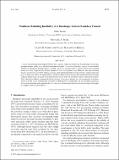Nonlinear Radiating Instability of a Barotropic Eastern Boundary Current
Author(s)
Wang, Jinbo; Spall, Michael A.; Flierl, Glenn Richard; Rizzoli, Paola M
DownloadWang-2013-Nonlinear radiating.pdf (1.266Mb)
PUBLISHER_POLICY
Publisher Policy
Article is made available in accordance with the publisher's policy and may be subject to US copyright law. Please refer to the publisher's site for terms of use.
Terms of use
Metadata
Show full item recordAbstract
Linear and nonlinear radiating instabilities of an eastern boundary current are studied using a barotropic quasigeostrophic model in an idealized meridional channel. The eastern boundary current is meridionally uniform and produces unstable modes in which long waves are most able to radiate. These long radiating modes are easily suppressed by friction because of their small growth rates. However, the long radiating modes can overcome friction by nonlinear energy input transferred from the more unstable trapped mode and play an important role in the energy budget of the boundary current system. The nonlinearly powered long radiating modes take away part of the perturbation energy from the instability origin to the ocean interior. The radiated instabilities can generate zonal striations in the ocean interior that are comparable to features observed in the ocean. Subharmonic instability is identified to be responsible for the nonlinear resonance between the radiating and trapped modes, but more general nonlinear triad interactions are expected to apply in a highly nonlinear environment.
Date issued
2013-07Department
Massachusetts Institute of Technology. Department of Earth, Atmospheric, and Planetary Sciences; Woods Hole Oceanographic InstitutionJournal
Journal of Physical Oceanography
Publisher
American Meteorological Society
Citation
Wang, Jinbo, Michael A. Spall, Glenn R. Flierl, and Paola Malanotte-Rizzoli. “Nonlinear Radiating Instability of a Barotropic Eastern Boundary Current.” J. Phys. Oceanogr. 43, no. 7 (July 2013): 1439–1452. © 2013 American Meteorological Society
Version: Final published version
ISSN
0022-3670
1520-0485